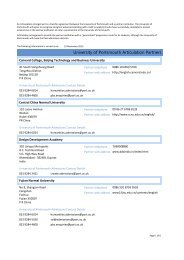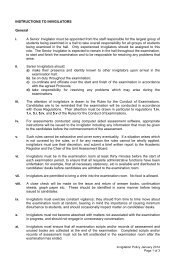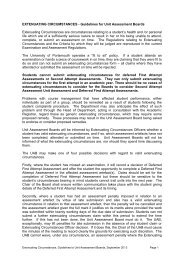Information Security - Incident Response Policy
Information Security - Incident Response Policy
Information Security - Incident Response Policy
Create successful ePaper yourself
Turn your PDF publications into a flip-book with our unique Google optimized e-Paper software.
<strong>Information</strong> <strong>Security</strong> <strong>Incident</strong> <strong>Response</strong> <strong>Policy</strong> & Procedures<br />
INFORMATION SECURITY<br />
INCIDENT RESPONSE<br />
POLICY & PROCEDURES<br />
(IS IRPP)<br />
October 2007<br />
Page 1 of 31
<strong>Information</strong> <strong>Security</strong> <strong>Incident</strong> <strong>Response</strong> <strong>Policy</strong> & Procedures<br />
POLICY STATEMENT<br />
A rapid response to incidents that threaten the confidentiality, integrity, and availability (CIA) of<br />
university information assets, information systems and the networks that deliver the information is<br />
required to protect those assets. Without a rapid response, those assets could be compromised and<br />
the university could be in breach of UK Legislation, JANET acceptable use policy and our own stated<br />
policies, there is also the potential of breaching the trust of our customers and users.<br />
The <strong>Information</strong> Services Management Team has identified improvement of <strong>Incident</strong> <strong>Response</strong> as a<br />
strategic task and has identified improvement of <strong>Information</strong> <strong>Security</strong> as a strategic goal.<br />
<strong>Information</strong> <strong>Security</strong> incidents will occur that require full participation of <strong>Information</strong> Services (IS)<br />
and IS technical personnel as well as management leadership to properly manage the outcome. To<br />
accomplish this IS will establish an incident response policy and procedures that will ensure<br />
appropriate leadership and technical resources are involved to:<br />
• assess of the seriousness of an incident<br />
• assess the extent of damage<br />
• identify the vulnerability created<br />
• estimate what additional resources are required to mitigate the incident<br />
It will also ensure that proper follow‐up reporting occurs and that procedures are adjusted so that<br />
responses to future incidents are improved.<br />
INFORMATION SECURITY INCIDENT RESPONSE POLICY &<br />
PROCEDURES<br />
These policies and procedures underlie the establishment and ongoing deployment of a trained<br />
incident response team, formed with the purpose of managing information security incidents at the<br />
University. This effort is being taken to improve the response time to incidents, to provide<br />
consistent response, and improve incident reporting. The purpose of the <strong>Information</strong> <strong>Security</strong><br />
<strong>Incident</strong> <strong>Response</strong> Procedure is to establish procedures in accordance with applicable legal and<br />
regulatory requirements and University policy to address instances of unauthorised access to or<br />
disclosure of University <strong>Information</strong>, to be known as an <strong>Incident</strong>.<br />
This policy applies to <strong>Information</strong> Services (IS) and all system and services for which it is<br />
responsible.<br />
Nothing in this <strong>Information</strong> <strong>Security</strong> <strong>Incident</strong> <strong>Response</strong> <strong>Policy</strong> & Procedure document should be<br />
taken to be in conflict with the following higher level policies:<br />
• Computer Use policy<br />
• Acceptable Use <strong>Policy</strong><br />
Page 2 of 31
<strong>Information</strong> <strong>Security</strong> <strong>Incident</strong> <strong>Response</strong> <strong>Policy</strong> & Procedures<br />
• Memoranda from the University Directorate<br />
These policies and procedures specifically exclude the following:<br />
• Non‐electronic information including paper mail.<br />
• Copier and fax.<br />
• Physical security.<br />
• Contingency Planning, Business Continuity and Disaster Recovery are governed by a<br />
different set of policies. An event may initially be declared an ‘<strong>Information</strong> <strong>Security</strong><br />
<strong>Incident</strong>’ and subsequently declared to be a ‘Disaster’ by the appropriate body. In this case,<br />
an <strong>Incident</strong> <strong>Response</strong> Team (IRT) would be included into the Disaster Recovery process.<br />
In addition to all the defences that have been mounted in protection of the infrastructure and the<br />
information processed within, conventional wisdom recommends a high level of preparedness for a<br />
information security incident. This policy and procedures describes the response to such events,<br />
the conditions whereby this process is invoked, the resources require and the course of<br />
recommended action. Central to this process is the <strong>Information</strong> Services <strong>Incident</strong> <strong>Response</strong> Team<br />
(IRT), assembled with the purpose of addressing that particular circumstance where there is<br />
credible evidence of an incident. See “Appendix A Process Flow –” for a graphical representation<br />
of the information flow and decision process.<br />
The primary emphasis of activities described within this policy is the return to a normal<br />
(secure) state as quickly as possible, whilst minimising the adverse impact to the University.<br />
The capture and preservation of incident relevant data (e.g., network flows, data on drives,<br />
access logs, etc.) is performed primarily for the purpose of problem determination and<br />
resolution, and methods currently employed are suitable for that purpose. It is understood<br />
and accepted that strict forensic measures are not used in the data capture and retention.<br />
Forensic measures will be determined on a case by case basis.<br />
This document may reference other documentation, policies and procedures that support this<br />
protocol but are not contained within the document, e.g., policy that defines sensitive data, scripts<br />
to be followed by the IS Service Desk, IS personnel, or documented IS IRT (<strong>Information</strong> Services<br />
<strong>Incident</strong> <strong>Response</strong> Team) procedures. Where this occurs, instructions to obtain these materials will<br />
be specified.<br />
Circumstances may dictate the activation of other operational teams and execution of other<br />
procedures. The IS IRT must monitor and co‐ordinate all activities occurring under other<br />
operational teams and protocols, and communicate to all interested parties in a timely manner to<br />
ensure accurate assessments and avoid efforts that may be duplicated or at cross‐purposes.<br />
SCOPE<br />
Page 3 of 31
<strong>Information</strong> <strong>Security</strong> <strong>Incident</strong> <strong>Response</strong> <strong>Policy</strong> & Procedures<br />
It is critical that the IS IRT provide consistent and timely response to the customer, and that<br />
sensitive information is handled appropriately. This document provides the guidelines needed for<br />
IRT <strong>Incident</strong> Managers (IM) to classify the case category, criticality level, and sensitivity level for<br />
each IRT case. This information will be entered into the <strong>Incident</strong> <strong>Response</strong> <strong>Incident</strong> Tracking<br />
System (IRIMS) when a case is created. Consistent case classification is required for the IRT to<br />
provide accurate reporting to management on a regular basis. In addition, the classifications will<br />
provide IRT IM’s with proper case handling procedures and will form the basis of Service Level<br />
Agreements (SLA) between the IRT and other University business areas.<br />
<strong>Information</strong> <strong>Security</strong> <strong>Incident</strong><br />
DEFINITIONS<br />
An <strong>Information</strong> <strong>Security</strong> <strong>Incident</strong> is generally defined as any known or highly suspected<br />
circumstance that results in an actual or possible unauthorised release of information<br />
deemed sensitive by the University or subject to regulation or legislation, beyond the<br />
University’s sphere of control.<br />
Examples of an <strong>Information</strong> <strong>Security</strong> <strong>Incident</strong> may include but are not limited to:<br />
• the theft or physical loss of computer equipment known to hold files containing financial<br />
details<br />
• a server known to hold sensitive data is accessed or otherwise compromised by an<br />
unauthorised party<br />
• an outside entity is subjected to a Distributed Denial of Service (DDoS) attack originating<br />
from within the University network<br />
• a firewall is accessed by an unauthorised entity<br />
• a network outage is attributed to the activities of an unauthorised entity<br />
CATEGORIES<br />
For the purposes of this protocol, incidents are categorised as “Unauthorised Access” or<br />
“Unauthorised Acquisition”, and can be recognised by associated characteristics.<br />
UNAUTHORISED ACCESS<br />
The unauthorised access to or disclosure of University information through network and/or<br />
computing related infrastructure, or misuse of such infrastructure, to include access to<br />
related components (e.g., network, server, workstation, router, firewall, system, application,<br />
data, etc.)<br />
Page 4 of 31
<strong>Information</strong> <strong>Security</strong> <strong>Incident</strong> <strong>Response</strong> <strong>Policy</strong> & Procedures<br />
Characteristics of security incidents where unauthorised access might have occurred may include<br />
but are not limited to:<br />
• Evidence (e‐mail, system log) of disclosure of sensitive data<br />
• Anomalous traffic to or from the suspected target<br />
• JANET CERT alerts<br />
• Unexpected changes in resource usage<br />
• Increased response time<br />
• System slowdown or failure<br />
• Changes in default or user‐defined settings<br />
• Unexplained or unexpected use of system resources<br />
• Unusual activities appearing in system or audit logs<br />
• Changes to or appearance of new system files<br />
• New folders, files, programs or executables<br />
• User lock out<br />
• Appliance or equipment failure<br />
• Unexpected enabling or activation of services or ports<br />
• Protective mechanisms disabled (firewall, anti‐virus)<br />
UNAUTHORISED ACQUISITION<br />
The unauthorised physical access to, disclosure or acquisition of assets containing or<br />
providing access to University information (e.g., removable drives or media, hardcopy, cable<br />
rooms, file or document storage, appliance hardware, etc.)<br />
Characteristics of security incidents where unauthorised acquisition might have occurred may<br />
include but are not limited to:<br />
• Theft of computer equipment where sensitive data is stored<br />
• Loss of storage media (removable drive, CD‐Rom, DVD, flash drive, magnetic tape)<br />
• Illegal entry (burglary)<br />
• Suspicious or foreign hardware is connected to the network<br />
Page 5 of 31
<strong>Information</strong> <strong>Security</strong> <strong>Incident</strong> <strong>Response</strong> <strong>Policy</strong> & Procedures<br />
• Normally‐secured storage areas found unsecured<br />
• Broken or non‐functioning locking mechanisms<br />
• Presence of unauthorised personnel in secured areas<br />
• Disabled security cameras or devices<br />
SEVERITY AND CRITICALITY<br />
<strong>Incident</strong>s are further delineated by the actual and potential impact on the business of the<br />
University. For additional information on severity assignments and associated symptoms, see<br />
“Appendix B <strong>Incident</strong> Severity and Criticality Levels,”. The primary focus of this policy is the<br />
handling of Severity 1 incidents.<br />
INCIDENT RESPONSE TEAM (IRT)<br />
The <strong>Incident</strong> <strong>Response</strong> Team (IRT) is comprised of individuals with decision‐making authority from<br />
within IS and charged by the Directorate with the responsibility of assisting in the process<br />
described within this document.<br />
UNIVERSITY INFORMATION<br />
University <strong>Information</strong> is any information asset which is maintained by or on behalf of the<br />
University that is used in the conduct of University business regardless of the manner in which such<br />
information is maintained or transmitted.<br />
SENSITIVE DATA<br />
Sensitive Data is:<br />
• Any University <strong>Information</strong> declared to be Highly Confidential, Confidential, or Restricted<br />
by University policy, and<br />
• Any personally identifiable information as determined or governed by The Data Protection<br />
Act 1998 or University policy requiring protection from disclosure.<br />
Examples include but are not limited to:<br />
• Network ID and Password<br />
• Student records<br />
• Personnel Records<br />
• Name in combination with address<br />
Page 6 of 31
<strong>Information</strong> <strong>Security</strong> <strong>Incident</strong> <strong>Response</strong> <strong>Policy</strong> & Procedures<br />
• Credit or Debit Card Number and Access Code (e.g., PIN or Password)<br />
• Personal Medical Records<br />
• Unpublished results of research or financial investment strategies<br />
• Intellectual Property (e.g., protected formulas or patents)<br />
UNIVERSITY CUSTOMER<br />
A University Customer is:<br />
• any faculty, student, staff or group affiliated with the University, or<br />
• any department or school of the University, or<br />
• any employee (permanent, temporary and contract personnel; past or present)<br />
3 RD PARTY<br />
A 3 rd party is:<br />
• any entity having a relationship with the University not described as a customer (e.g.,<br />
business partner, research subject, vendor), or<br />
• any external entity initiating contact with the University (e.g., JANET CERT, RIAA , target of<br />
DDoS attack, student applicant, member of the general public).<br />
TEAM OBJECTIVES<br />
The IS IRT Chair (Director of <strong>Information</strong> Services) or delegated <strong>Incident</strong> Manager (IM) will lead the<br />
IRT team; the IRT’s objective is to:<br />
1. Coordinate and oversee the response to <strong>Incident</strong>s in accordance with the<br />
requirements of UK Legislation, JANET and University policy;<br />
2. Minimise the potential negative impact to the University, Customers and and 3 rd<br />
Parties as a result of such <strong>Incident</strong>s;<br />
3. Where appropriate, inform the affected Customer and 3 rd Party of action that is<br />
recommended or required on their behalf;<br />
4. Restore services to a normal and secure state of operation.<br />
5. Provide clear and timely communication to all interested parties.<br />
RESPONSIBILITIES<br />
Page 7 of 31
<strong>Information</strong> <strong>Security</strong> <strong>Incident</strong> <strong>Response</strong> <strong>Policy</strong> & Procedures<br />
To ensure an appropriate and timely execution of this protocol, the IRT Chair (or designated IRT<br />
IM) is required to:<br />
1. Confirm the occurrence of an <strong>Information</strong> <strong>Security</strong> <strong>Incident</strong> requiring the execution<br />
of this protocol.<br />
2. Confirmation activities include but are not limited to:<br />
• examination or analysis of anomalies or untoward events<br />
• review of system logs or audit records<br />
• direct conversation with Customer, 3rd Party, Service Desk, IS personnel,<br />
“on call” engineer, IRT members or others having information about the event<br />
collection of any evidence supportive of the event<br />
• Supervise and direct the consistent, timely, and appropriate response to an<br />
<strong>Information</strong> <strong>Security</strong> <strong>Incident</strong><br />
• Provide appropriate communication to parties having a vested interest in<br />
the incident.<br />
• Offer support to the Customer or 3 rd Party as appropriate until the <strong>Incident</strong><br />
is resolved.<br />
• Conduct a Post‐<strong>Incident</strong> Review (PIR).<br />
• Maintain the procedures contained in this document.<br />
CRITICAL INCIDENT RESPONSE TEAM COMPOSITION<br />
The IRT consists of a Primary Team and if deemed necessary a Secondary Team. Each member of<br />
the Primary Team will designate an Alternate member to participate if the Primary Member is<br />
unavailable. See Appendix C “Primary and Alternate Contact List ” for a listing of individual<br />
members. The Primary Team will consist of representatives from the following areas:<br />
A1. PRIMARY TEAM (REQUIRED)<br />
1. Director of IS (Chair)<br />
2. Senior Service Delivery Manager (SSDM)<br />
3. University <strong>Information</strong> Group Manager (UIG)<br />
4. University Applications Group Manager (UAG)<br />
5. IS Technical Personnel<br />
Page 8 of 31
<strong>Information</strong> <strong>Security</strong> <strong>Incident</strong> <strong>Response</strong> <strong>Policy</strong> & Procedures<br />
6. <strong>Security</strong> Architect (SA)<br />
7. Change Manager (CM)<br />
8. Administration Support<br />
A2. SECONDARY TEAM (AS REQUIRED)<br />
The circumstances surrounding each incident may differ and require personnel with expertise or<br />
skills beyond that of the Primary Team. Members of the Primary Team will determine what, if any,<br />
additional resources are required and a Secondary Team may be established with:<br />
• Individuals with decision‐making authority identified to have a vested interest in the<br />
resolution of the incident.<br />
• Individuals identified as subject matter experts or having skills required for resolution of<br />
the incident.<br />
<strong>Information</strong> <strong>Security</strong> Coordinators representing an affected Customer or 3 rd Party, or known to<br />
have an established relationship with an affected Customer or 3 rd Party may be seconded to the<br />
Secondary Team.<br />
ACCOUNTABILITY<br />
Individual IRT members are accountable to the IS Senior Management Team and University<br />
Directorate for the timely and effective execution of this policy, procedures and associated<br />
activities.<br />
REPORTING A SECURITY INCIDENT<br />
Anyone receiving notification of an <strong>Incident</strong> must contact the Service Desk immediately.<br />
Service Desk personnel will provide the customer and the user with a Single Point of Contact<br />
(SPOC). The Service Desk own the <strong>Incident</strong> Management Process and as such the will be<br />
responsible for monitoring and escalation according to all SLA’s<br />
• The e‐mail addresses is servicedesk@port.ac.uk<br />
Note: The email address may be used but is less effective than the direct notification to the Service<br />
Desk via the telephone.<br />
• Telephone Ext: 3265<br />
Service Desk personnel use scripts (e.g., lists of predetermined questions) to assist in problem<br />
determination and resolution. These scripts assist support personnel to identify those events that<br />
may be classified as an <strong>Information</strong> <strong>Security</strong> <strong>Incident</strong>. Additional information may be found in<br />
Appendix D – “Guidelines for Service Desk and IS Personnel”.<br />
Page 9 of 31
<strong>Information</strong> <strong>Security</strong> <strong>Incident</strong> <strong>Response</strong> <strong>Policy</strong> & Procedures<br />
ACTIVATION OF TEAM<br />
Once the IRT Lead has determined an <strong>Information</strong> <strong>Security</strong> <strong>Incident</strong> has occurred, the IRT Lead or<br />
delegated IRT IM will activate this protocol within 24 hours after <strong>Incident</strong> determination.<br />
Notification to the Primary Team member or Alternate should occur via a direct communication by<br />
telephone or face‐to‐face contact. Voice‐mail and e‐mail are not considered direct notification.<br />
Respective Primary and Alternate Team members should exchange information frequently to<br />
ensure their knowledge of the information security incident is current.<br />
Consult Appendix – E “Notification Tree” for details and notification assignments.<br />
KEY COMPONENTS OF CRITICAL INCIDENT RESPONSE PROTOCOL<br />
The Critical <strong>Incident</strong> <strong>Response</strong> Protocol consists of five key components:<br />
• Assessment<br />
• Notification/Communication<br />
• Containment,<br />
• Corrective Measures<br />
• Closure<br />
ASSESSMENT<br />
The IRT Lead or IRT IM will determine the category and severity of the <strong>Incident</strong> and undertake<br />
discussions and activities to best determine the next best course of action, i.e., decide if protocol<br />
execution is required. Appendix F “Critical <strong>Incident</strong> Assessment Checklist” is used in the initial<br />
assessment process conducted by the IRT Lead. Once the IRT is assembled, the Assessment<br />
Checklist is executed and reviewed to ensure all pertinent facts are established. All discussions,<br />
decisions and activities are to be documented.<br />
NOTIFICATION/COMMUNICATION<br />
Designated persons will take action to notify the appropriate internal and external parties, as<br />
necessary.<br />
INTERNAL NOTIFICATION (WITHIN THE UNIVERSITY)<br />
All Internal Notification and communication must be approved by the Primary IRT Lead or<br />
IRT IM.<br />
Primary Team members notify Alternate Team members (and vice‐versa). The IRT will notify<br />
members of Secondary Team (if assembled).<br />
Page 10 of 31
<strong>Information</strong> <strong>Security</strong> <strong>Incident</strong> <strong>Response</strong> <strong>Policy</strong> & Procedures<br />
1. IRT Lead will notify University Administration and IT Committee of the <strong>Incident</strong> and provide<br />
ongoing status.<br />
2. IRT Lead will issue or direct all “sensitive” internal communications.<br />
3. Service Desk will issue all public internal communication.<br />
EXTERNAL NOTIFICATION (OUTSIDE THE UNIVERSITY)<br />
All External Notification and communication must be approved by the Directorate.<br />
1. 3 rd Party ‐ IRT Lead or IRT IM and the Directorate will establish communication with any 3 rd<br />
Party, as appropriate for the circumstance.<br />
2. Law Enforcement ‐ <strong>Security</strong> Architect in consultation with IRT Lead or IRT IM to notify Law<br />
Enforcement as appropriate.<br />
3. Regulatory ‐ Directorate notifies the appropriate regulatory agencies.<br />
4. IRT members will assist in determining if other parties should be notified (e.g. Sun <strong>Security</strong>).<br />
5. Media Interest ‐ Directorate and University Public Relations will determine if, how and when<br />
media interest should be notified, and respond to all inquiries from the media.<br />
6. Directorate will determine if government notification (e.g., <strong>Information</strong> Commissioner) is<br />
required and take appropriate action.<br />
7. Other affected parties – The IRT will determine if there are other parties of interest, with<br />
communications issued accordingly (e.g., JANET CERT)<br />
CUSTOMER NOTIFICATION<br />
1. Customers should be informed that the <strong>Incident</strong> has been reported, recorded and an<br />
investigation underway.<br />
2. The Customer shall be kept abreast of the status of the <strong>Incident</strong> investigation in a timely<br />
manner.<br />
3. The Customer shall be notified of results, closure of investigation, and recommendations.<br />
STATUS<br />
1. IRT Lead assumes responsibility for preparing and issuing timely communication to IRT<br />
members, Administration and other interested parties.<br />
2. Communications may include meetings, video conferencing, teleconferencing, e‐mail,<br />
telephone/messaging, voice recordings or other means as deemed appropriate.<br />
Page 11 of 31
<strong>Information</strong> <strong>Security</strong> <strong>Incident</strong> <strong>Response</strong> <strong>Policy</strong> & Procedures<br />
3. Frequency and timeliness of communications will be established and revised throughout<br />
the life cycle of the incident.<br />
CONTAINMENT<br />
The IRT will determine and cause to be executed the appropriate activities and processes required<br />
to quickly contain and minimise the immediate impact to the University, Customer and 3 rd Party.<br />
Recommended activities addressing Unauthorised Access and Unauthorised Acquisition are<br />
described in Appendix G “<strong>Incident</strong> Containment Activities”.<br />
Containment activities are designed with the primary objectives of:<br />
• Counteract the immediate threat<br />
• Prevent propagation or expansion of the incident<br />
• Minimise actual and potential damage<br />
• Restrict knowledge of the incident to authorised personnel<br />
• Preserve information relevant to the incident<br />
CORRECTIVE MEASURES<br />
The IRT will determine and cause to be executed the appropriate activities and processes required<br />
to quickly restore circumstances to a normal (secure) state. Recommended activities addressing<br />
Unauthorised Access and Unauthorised Acquisition are described in Appendix H “Corrective<br />
Measures”.<br />
Corrective measures are designed with the primary objectives of:<br />
• Secure the processing environment<br />
• Restore the processing environment to its normal state<br />
CLOSURE<br />
The IRT will stay actively engaged throughout the life cycle of the <strong>Information</strong> <strong>Security</strong> <strong>Incident</strong> to<br />
assess the progress/status of all containment and corrective measures and determine at what point<br />
the incident can be considered resolved. Recommendations for improvements to processes,<br />
policies, procedures, etc. will exist beyond the activities required for incident resolution and should<br />
not delay closing the <strong>Information</strong> <strong>Security</strong> <strong>Incident</strong>.<br />
REQUIRED DOCUMENTATION FOR CRITICAL INCIDENT RESPONSE<br />
MEETINGS<br />
All <strong>Incident</strong> activities, from receipt of the initial report through Post‐<strong>Incident</strong> Review, are to be<br />
documented. The IRT Lead is responsible for ensuring all events are recorded, assembling these<br />
Page 12 of 31
<strong>Information</strong> <strong>Security</strong> <strong>Incident</strong> <strong>Response</strong> <strong>Policy</strong> & Procedures<br />
records in preparation and performance of the post‐incident review, and ensuring all records are<br />
preserved for review. IRT members may be employed in these efforts.<br />
1. General overview of the <strong>Incident</strong><br />
Summary of the <strong>Incident</strong> providing a general description of events, approximate timelines, and<br />
parties involved, resolution of the incident, external notifications required and<br />
recommendations for prevention and remediation.<br />
2. Detailed review of the <strong>Incident</strong>.<br />
Description of <strong>Incident</strong> events, indicating specific timelines, personnel involved, hours spent on<br />
various activities, impact to Customer, 3 rd Party and user communities (e.g., system not<br />
available, business continuity issues), ensuing discussions, decisions and assignments made,<br />
problems encountered, successful and unsuccessful activities, notifications required or<br />
recommended, steps taken for containment and remediation, recommendations for prevention<br />
and remediation (short‐term and long‐term), identification of policy and procedure gaps,<br />
results of post‐incident review.<br />
3. Retention.<br />
All relevant documentation will be retained by IRT Lead for archival in a central repository.<br />
Access to the documentation and repository is typically restricted to IRT membership.<br />
POST‐INCIDENT REVIEW (PIR)<br />
A review of <strong>Information</strong> <strong>Security</strong> <strong>Incident</strong>‐related activities is a required element of this policy. All<br />
members of the IRT primary and secondary teams are recommended participants.<br />
Discussion<br />
The IRT Lead or IRT IM will host a PIR after each <strong>Incident</strong> has been resolved; this discussion should<br />
be scheduled within 2‐3 weeks of the <strong>Information</strong> <strong>Security</strong> <strong>Incident</strong>’s remediation. The review is an<br />
examination of the <strong>Incident</strong> and all related activities and events. All activities performed relevant<br />
to the <strong>Incident</strong> should be reviewed with the aim of improving and honing the over‐all incident<br />
response process.<br />
1. Recommendations<br />
The IRT’s recommendations on changes to policy, process, safeguards, etc. are both an input to<br />
and by‐product of this review. “Fix the problem, not the blame” is the focus of this activity. All<br />
discussions, recommendations and assignments are to be documented for distribution to the<br />
IRT and follow‐up by IRT Lead.<br />
2. Followup<br />
The IRT Lead will follow‐up with the Client and 3 rd Party or other parties, as required and<br />
appropriate.<br />
Page 13 of 31
<strong>Information</strong> <strong>Security</strong> <strong>Incident</strong> <strong>Response</strong> <strong>Policy</strong> & Procedures<br />
GLOSSARY<br />
The following terms should be used to assure commonality of reporting:<br />
Confidentiality. “Confidentiality provides the ability to ensure that the necessary level of security<br />
is enforced at each junction of data processing and prevention of unauthorised disclosure. This<br />
level of confidentiality should prevail while data resides on systems and devices within the<br />
network, as it is transmitted, and once it reaches its destination.” Harris 2003,p55<br />
Integrity. “Integrity is upheld when the assurance of accuracy and reliability of information and<br />
systems is provided, and unauthorised modification of data is prevented.” Harris 2003, p. 55.<br />
Availability. “Systems and networks should provide adequate capacity in order to perform in a<br />
predictable manner with an acceptable level of performance.” Harris 2003, p. 54.<br />
Vulnerability. “Vulnerability is a software, hardware, or procedural weakness that may provide an<br />
attacker the open door he is looking for to enter a computer or network and have unauthorised<br />
access to resources within the environment. Vulnerability characterises the absence or weakness<br />
of a safeguard that could be exploited”. Harris 2003, p. 56.<br />
Threat. “A threat is any potential danger to information systems. The threat is that someone or<br />
something will identify a specific vulnerability and use it against the organisation or individual”.<br />
Harris 2003, p. 56.<br />
Risk. “A risk is the likelihood of a threat agent taking advantage of vulnerability. A risk is the<br />
possibility and probability that a threat agent will exploit vulnerability”. Harris 2003, p. 56.<br />
Exposure. “An exposure is an instance of being exposed to losses from a threat agent.<br />
Vulnerability can cause an organisation to be exposed to possible damages”. Harris 2003, p. 56.<br />
Countermeasure. “A countermeasure, or safeguard, mitigates a potential risk. A countermeasure<br />
is a software configuration, hardware, or procedure that eliminates vulnerability or reduces the risk<br />
of a threat agent from being able to exploit vulnerability”. Harris 2003, p. 57.<br />
Page 14 of 31
<strong>Information</strong> <strong>Security</strong> <strong>Incident</strong> <strong>Response</strong> <strong>Policy</strong> & Procedures<br />
APPENDICES<br />
A – Process Flow<br />
B – <strong>Incident</strong> Severity and Criticality Level<br />
C – Primary and Alternate Contact List<br />
D – Guidelines for Service Desk and IS Personnel<br />
E – Notification Tree<br />
F – <strong>Incident</strong> Assessment Checklist<br />
G – <strong>Incident</strong> Containment Activities<br />
H – Corrective Measures<br />
APPENDIX A ‐ PROCESS FLOW<br />
Page 15 of 31
<strong>Information</strong> <strong>Security</strong> <strong>Incident</strong> <strong>Response</strong> <strong>Policy</strong> & Procedures<br />
Page 16 of 31
<strong>Information</strong> <strong>Security</strong> <strong>Incident</strong> <strong>Response</strong> <strong>Policy</strong> & Procedures<br />
APPENDIX ‐ B INCIDENT SENSITIVITY AND CRITICALITY LEVELS<br />
SCOPE<br />
It is important that the SPOC provide consistent and timely response to the customer, and that sensitive<br />
information is handled appropriately. This document provides the guidelines needed for IRT <strong>Incident</strong><br />
Managers (IM) to classify the case category, sensitivity level, and criticality level for each IRT case. This<br />
information will be entered into the IRIMS when a case is created. Consistent case classification is required<br />
for the IRT to provide accurate reporting to management on a regular basis. In addition, the classifications<br />
will provide IRT IM’s with proper case handling procedures and will form the basis of SLA’s between the IRT<br />
and IS Service Delivery and other university clients.<br />
INCIDENT CATEGORY AND SENSITIVITY LEVELS<br />
All incidents managed by the IRT should be classified into one of the categories listed in the table below:<br />
<strong>Incident</strong><br />
Sensitivity* Description<br />
Category<br />
Denial of service S3 • DOS or DDOS attack.<br />
Forensics S1 • Any forensic work to be done by IRT.<br />
Compromised<br />
<strong>Information</strong><br />
S1 • Attempted or successful destruction, corruption, or disclosure of sensitive university<br />
information or Intellectual Property.<br />
Compromised Asset S1, S2 • Compromised host (root account, Trojan, rootkit), network device, application, user<br />
account. This includes malware‐infected hosts where an attacker is actively<br />
controlling the host.<br />
Unlawful activity S1 • Theft / Fraud / Human Safety / Child Pornography. Computer‐related incidents of a<br />
criminal nature, likely involving law enforcement or Loss Prevention.<br />
Internal Hacking S1, S2, S3 • Reconnaissance or Suspicious activity originating from inside the university network,<br />
excluding malware.<br />
External Hacking S1, S2, S3 • Reconnaissance or Suspicious Activity originating from outside the university network<br />
(partner network, Internet), excluding malware.<br />
Malware S3 • A virus or worm typically affecting multiple university devices. This does not include<br />
compromised hosts that are being actively controlled by an attacker via a backdoor or<br />
Trojan. (See Compromised Asset)<br />
Email S3 • Spoofed email, SPAM, and other email security‐related events.<br />
Consulting S1, S2, S3 • <strong>Security</strong> consulting unrelated to any confirmed incident.<br />
<strong>Policy</strong> Breaches S1, S2, S3 • Sharing offensive material, sharing/possession of copyright material.<br />
• Deliberate violation of <strong>Information</strong> <strong>Security</strong> policy.<br />
• Inappropriate use of university asset such as computer, network, or application.<br />
• Unauthorised escalation of privileges or deliberate attempt to subvert access<br />
controls.<br />
* ‐ Sensitivity will vary depending on circumstances.<br />
SENSITIVITY CLASSIFICATION EXAMPLES<br />
Page 17 of 31
<strong>Information</strong> <strong>Security</strong> <strong>Incident</strong> <strong>Response</strong> <strong>Policy</strong> & Procedures<br />
The IRT should always apply the “need to know” principle when communicating case details with other<br />
parties. The sensitivity matrix below helps to define “need to know” by classifying cases according to<br />
sensitivity level. The ‘Required’ column defines the parties that “need to know” for a given sensitivity level.<br />
The ‘Optional’ column defines the other parties that may be included on communications, if necessary.<br />
Typically the SPOC who own the incident will initially determine the sensitivity level. In some cases it will be<br />
appropriate for the SPOC to work with the customer to determine the sensitivity level and then if deemed<br />
necessary escalate the incident to the IRT.<br />
Sensitivity Classification<br />
Sensitivity<br />
Level<br />
S1<br />
S2<br />
S3<br />
Sensitivity<br />
Level<br />
Definition<br />
Extremely<br />
Sensitive.<br />
Sensitive.<br />
Not Sensitive.<br />
Typical <strong>Incident</strong> Categories<br />
Global Investigations<br />
Initiated<br />
Forensics Request<br />
Destruction of property<br />
Compromised asset<br />
Compromised <strong>Information</strong><br />
Unlawful activity<br />
Inappropriate use of<br />
property<br />
<strong>Policy</strong> violations<br />
External Hacking<br />
Internal Hacking<br />
Unauthorised Access<br />
Denial of service<br />
Virus / Worm<br />
Email<br />
Required On Case<br />
Communications **<br />
IRT Lead or IRT IM,<br />
<strong>Security</strong> Architect or<br />
SPOC<br />
IRT Lead or IRM IM,<br />
<strong>Security</strong> Architect ,<br />
SPOC<br />
IRT Lead or IRT IM, ,<br />
<strong>Security</strong> Architect or<br />
SPOC<br />
Optional On Case<br />
Communications **<br />
JANET CERT<br />
JANET CERT<br />
OWNERS<br />
ANY<br />
OWNERS<br />
ANY<br />
IRIMS Access<br />
IRT Lead or IRT IM<br />
<strong>Security</strong> Architect<br />
or SPOC<br />
<strong>Security</strong> Architect<br />
or SPOC<br />
Service Desk<br />
personnel with<br />
access to IRIMS<br />
<strong>Security</strong> Architect<br />
Definitions:<br />
• SPOC: The service delivery single point of contact, the person that initiated the case with the IRT. This is the person in the Service<br />
Desk team that initiated a case with the IRT.<br />
• IRT: This includes the dedicated IRT members, and the IRT Lead/IRT IM handling the case.<br />
• OWNERS: The owners of the affected device/application (system administrator, webmaster, etc.)<br />
• ANY: Any other relevant parties that may be affected including various university customers. It is left to the discretion of the IRT IM to<br />
determine who should be included.<br />
• IRIMS: <strong>Incident</strong> <strong>Response</strong> <strong>Information</strong> Management System,<br />
Notes:<br />
** “Case Communications” include the following: Initial email from SPOC to customer, periodic case reports to customer, and final case report to<br />
customer. It is not necessary to include these parties on all interim communications that occur throughout the life of a case, just the case updates<br />
and summary.<br />
CRITICALITY CLASSIFICATION<br />
Page 18 of 31
<strong>Information</strong> <strong>Security</strong> <strong>Incident</strong> <strong>Response</strong> <strong>Policy</strong> & Procedures<br />
The criticality matrix defines the minimal customer response time and ongoing communication requirements<br />
for a case. The criticality level should be entered into the IRIMS when a case is created, and it should not be<br />
altered at any point during the case lifecycle except when it was incorrectly classified in the first place.<br />
Typically the SPOC will determine the initial criticality level and in some cases it will be appropriate to<br />
escalate to the IRT Lead or IRT IM to work with the SPOC and the customer to determine the criticality level.<br />
Level<br />
C1<br />
Criticality Level<br />
Definition<br />
<strong>Incident</strong> affecting critical<br />
systems or information<br />
with potential to be<br />
revenue or customer<br />
impacting.<br />
Typical <strong>Incident</strong><br />
Categories<br />
Denial of service<br />
Compromised Asset<br />
(critical)<br />
Internal Hacking<br />
(active)<br />
External Hacking<br />
(active)<br />
Virus / Worm<br />
(outbreak)<br />
Destruction of property<br />
(critical)<br />
Criticality Classification<br />
Initial<br />
Respon<br />
se Time<br />
60<br />
Minutes<br />
Ongoing<br />
<strong>Response</strong><br />
(Critical Phase)<br />
IRT Lead or IRT<br />
<strong>Incident</strong> Manager<br />
assigned to work<br />
case on 24x7 basis.<br />
Ongoing<br />
<strong>Response</strong><br />
(Resolution<br />
Phase)<br />
IRT <strong>Incident</strong><br />
Manager<br />
assigned to work<br />
on case during<br />
normal business<br />
hours.<br />
Ongoing<br />
Communication<br />
Requirement<br />
Case update sent to<br />
appropriate parties<br />
on a daily basis<br />
during critical<br />
phase. If IRT<br />
involvement is<br />
necessary to<br />
restore critical<br />
systems to service<br />
then case update<br />
will be sent a<br />
minimum of every<br />
2 hours.<br />
Case update sent to<br />
appropriate parties<br />
on a weekly basis<br />
during resolution<br />
phase.<br />
C2<br />
<strong>Incident</strong> affecting noncritical<br />
systems or<br />
information, not revenue<br />
or customer impacting.<br />
Employee investigations<br />
that are time sensitive<br />
should typically be<br />
classified at this level.<br />
C3 Possible incident, noncritical<br />
systems.<br />
<strong>Incident</strong> or employee<br />
investigations that are<br />
not time sensitive.<br />
Long‐term investigations<br />
involving extensive<br />
research and/or detailed<br />
forensic work.<br />
Internal Hacking (not<br />
active)<br />
External Hacking (not<br />
active)<br />
Unauthorised access.<br />
<strong>Policy</strong> breaches<br />
Unlawful activity.<br />
Compromised<br />
information.<br />
Compromised asset.<br />
(non‐critical)<br />
Destruction of property<br />
(non‐critical)<br />
Email<br />
Forensics Request<br />
Inappropriate use of<br />
property.<br />
<strong>Policy</strong> breaches.<br />
4 Hours IRT Lead or IRT<br />
<strong>Incident</strong> Manager<br />
assigned to work<br />
case on 24x7 basis.<br />
48 Hours Case is worked as<br />
IRT time/resources<br />
are available.<br />
IRT <strong>Incident</strong><br />
Manager<br />
assigned to work<br />
on case during<br />
normal business<br />
hours.<br />
Case is worked as<br />
IRT<br />
time/resources<br />
are available.<br />
Case update sent to<br />
appropriate parties<br />
on a daily basis<br />
during critical<br />
phase.<br />
Case update sent to<br />
appropriate parties<br />
on a weekly basis<br />
during<br />
resolution phase.<br />
Case update sent to<br />
appropriate parties<br />
on a weekly basis.<br />
Page 19 of 31
<strong>Information</strong> <strong>Security</strong> <strong>Incident</strong> <strong>Response</strong> <strong>Policy</strong> & Procedures<br />
e.g. A compromised root account on a Sun Solaris Server containing personnel information would be:<br />
• Compromised Asset Sun Solaris Server<br />
• Sensitivity S1<br />
• Criticality Classification C1<br />
Definitions:<br />
• Initial <strong>Response</strong> Time – This specifies the maximum amount of time that should elapse before the Service<br />
Desk responds to the customer/user. Again, this is the maximum amount of time. In most cases the IRT<br />
Lead or IRT IM will respond sooner than the specified response time. At a minimum, the following should<br />
occur within this timeframe:<br />
•<br />
1. Initial assessment and triage.<br />
2. Case classification is determined.<br />
3. The case will be entered into the IRIMS.<br />
4. The case will be owned by the Service Desk<br />
5. An email will be sent to the customer. This is the initial “we have your case” email. This email will<br />
include various information ( to be defined in another document ) such as the date/time of the<br />
request, IRT case number, the name, phone, and email of the IRT Lead or IRTM IM, a SPOC<br />
escalation contact, the criticality and sensitivity level of the case, and an indication of when the<br />
customer will receive case updates. Ideally, the IRIMS will generate this email automatically when a<br />
case is entered into the system.<br />
• Ongoing <strong>Response</strong> Requirement ‐ This specifies the level of service that the customer will receive from the<br />
IRT.<br />
• Ongoing Communication Requirement – This specifies the frequency in which communications with the<br />
customer should occur throughout the case lifecycle. These are the minimum requirements and<br />
communications may occur more frequently as required.<br />
<strong>Incident</strong> Phases:<br />
<strong>Incident</strong> Phase Description Typical Activities<br />
Critical Phase<br />
The period of time in the case lifecycle when active incident<br />
response is required in order to ensure the successful<br />
resolution of the case. Typically this includes system or service<br />
outages, and/or urgent evidence preservation.<br />
Detection, assessment, triage, containment,<br />
evidence preservation, initial recovery<br />
Resolution Phase<br />
The period of time in the case lifecycle when active incident<br />
response is not required to successfully resolve the case.<br />
Evidence collection, analysis and investigation,<br />
forensics, remediation, full recovery, post‐mortem.<br />
Notes:<br />
The IRIMS should be modified to include a drop‐down selection for incident phase ( ‘Critical’, ‘Resolution’, ‘N/A’ ). For<br />
cases that are classified as C1 or C2 this field will be set to Critical when the case is opened, and will be reset to<br />
‘Resolution’ at the appropriate time in the case lifecycle. For cases that are not time‐sensitive (typically C3) the SPOC<br />
will set this field to ‘N/A’. Having this distinction will allow IRT personnel and IS Management to easily distinguish<br />
between cases that are critical and active from those that are not being actively worked.<br />
Page 20 of 31
<strong>Information</strong> <strong>Security</strong> <strong>Incident</strong> <strong>Response</strong> <strong>Policy</strong> & Procedures<br />
APPENDIX D ‐ GUIDELINES FOR SERVICE DESK AND IS STAFF<br />
PRIMARY OBJECTIVE<br />
The primary objective is to determine if the problem being reported is a security incident. In most<br />
instances, the problem being reported will not constitute an incident as defined within the policy ‐<br />
(see Definitions – <strong>Information</strong> <strong>Security</strong> <strong>Incident</strong> ‐ Categories).<br />
No set of questions will address every circumstance; previous experience with an individual and<br />
intuition may be relied upon to help determine if an incident has occurred. Service Desk personnel<br />
are accountable for asking the questions about an incident, making a reasonable attempt at<br />
determining if an incident has occurred, recording facts and responses to questions, and forwarding<br />
pertinent information to the responsible parties.<br />
PROBLEM REPORTING<br />
Familiarity with the policy definitions and glossary will assist support personnel in making a<br />
determination if a security incident has occurred. Individuals reporting problems and/or incidents<br />
should be informed as to the reason for the questions (i.e., the University is attempting to<br />
determine if sensitive data is at risk or compromised) and all individuals should be encouraged to<br />
openly discuss the problem being reported. Any information provided by an individual that helps<br />
in the determination is of considerable value; the individual’s cooperation is critical, greatly<br />
appreciated and should be recognised.<br />
INQUIRIES<br />
For those individuals who may be reporting a security incident, questions that might be asked<br />
include but are not limited to:<br />
• Were Network ID’s and/or passwords accessed or released?<br />
• Were medical records of individuals present or accessed?<br />
• Were credit card numbers or financial information disclosed?<br />
• Did physical theft of computer equipment occur?<br />
• Was “foreign” or unauthorised equipment connected to the network?<br />
DISCOVERY AND REPORTING<br />
If the answers to the inquiries indicate that an incident may have occurred, service desk staff<br />
personnel should assume that an incident has actually occurred and perform the following<br />
activities:<br />
• Obtain and record the contact information for the individual reporting the problem<br />
(name, telephone numbers, email address)<br />
• Record relevant information about the incident (e.g., time/date of suspected<br />
occurrence, type of information compromised, location of the compromise)<br />
Page 21 of 31
<strong>Information</strong> <strong>Security</strong> <strong>Incident</strong> <strong>Response</strong> <strong>Policy</strong> & Procedures<br />
• Inform the individual to expect contact from a member of the <strong>Incident</strong> <strong>Response</strong><br />
Team<br />
• Request the individual to treat the incident as a confidential matter<br />
• Contact a member of the IRT team or “on call” IS IRT IM for further assistance.<br />
ESCALATION<br />
The Service Delivery Team SPOC is responsible for making an early determination if an incident has<br />
occurred or might be indicated. If the SPOC believes an incident has occurred, might be indicated,<br />
or unsure, the IRT Lead or IRT <strong>Incident</strong> Manager should be contacted immediately, using the<br />
department’s notification procedures.<br />
Page 22 of 31
<strong>Information</strong> <strong>Security</strong> <strong>Incident</strong> <strong>Response</strong> <strong>Policy</strong> & Procedures<br />
APPENDIX E ‐ NOTIFICATION TREE<br />
Page 23 of 31
<strong>Information</strong> <strong>Security</strong> <strong>Incident</strong> <strong>Response</strong> <strong>Policy</strong> & Procedures<br />
APPENDIX F ‐ INCIDENT ASSESSMENT CHECKLIST<br />
The activities described in this checklist are designed to assist in the initial assessment process<br />
performed and/or conducted by the Service Desk SPOC.<br />
Completion of this checklist is essential for any incident that calls for the execution of the IS<br />
<strong>Incident</strong> <strong>Response</strong> Procedures. Once the IS IRT is assembled, the Assessment Checklist is reviewed<br />
for completion to ensure all pertinent facts have been established.<br />
A. DESCRIPTION OF INCIDENT DATA RELEVANT TO THE INCIDENT SHOULD BE<br />
COLLECTED FOR USE IN THE PROCESS OF INCIDENT DETERMINATION.<br />
A1. Record the current date and time.<br />
A2. Provide a brief description of the <strong>Incident</strong>.<br />
A3. Who discovered the <strong>Incident</strong>? Provide name and contact information.<br />
A4. Indicate when the incident occurred and when it was discovered.<br />
A5. How was the <strong>Incident</strong> discovered?<br />
A6. Describe the evidence that substantiates or corroborates the <strong>Incident</strong> (e.g., eye‐witness, timestamped<br />
logs, screenshots, video footage, hardcopy, etc.).<br />
A7. Identify all known parties with knowledge of the <strong>Incident</strong> as of current date and time.<br />
A8. Have all parties with knowledge of the <strong>Incident</strong> been informed to treat information about the<br />
<strong>Incident</strong> as “sensitive or confidential”?<br />
B. TYPES OF INFORMATION, SYSTEMS AND MEDIA PROVIDE INFORMATION ON THE<br />
NATURE OF THE DATA THAT IS RELEVANT TO THE INCIDENT.<br />
B1. Provide details on the nature of the data (e.g., student information, research data, personnel<br />
information etc.).<br />
B2. Does the information (if compromised) constitute a breach of of regulatory requirements (e.g.,<br />
Data Protection or University policy? Describe what is known.<br />
B3. Was the compromised information maintained by a University Client or a 3 rd Party? Provide<br />
details.<br />
B4. How was the information held? Identify the types of information systems and/or the media on<br />
which the information was stored (e.g., hardcopy, laptop, CD‐Rom, etc.).<br />
Page 24 of 31
<strong>Information</strong> <strong>Security</strong> <strong>Incident</strong> <strong>Response</strong> <strong>Policy</strong> & Procedures<br />
B5. If the information was held electronically, was the data encrypted or otherwise disguised or<br />
protected (e.g., redacted, partial strings, password required, etc.)? If so, describe measures taken.<br />
B6. If a customer held the information:<br />
‐ Establish the customer point of contact. (e.g. JANET )<br />
‐ Assign responsibility to IRT member to contact the customer.<br />
B7. If a 3 rd Party held the information:<br />
‐ Identify the individual within the University who best represents the 3 rd Party. If there is no<br />
suitable University contact, an IRT member will be assigned responsibility for directly contacting<br />
the 3 rd Party.<br />
‐ Assign responsibility to IRT member to contact that individual.<br />
‐ IRT member will work with the University contact or 3 rd Party to obtain a copy of any contract or<br />
confidentiality agreement and ascertain what knowledge of the <strong>Incident</strong> the 3 rd Party might have<br />
and what action if any has been taken.<br />
B8. Who currently holds evidence of the <strong>Incident</strong>? Provide name and contact information.<br />
B9. What steps are required or being taken to preserve evidence of the <strong>Incident</strong>? Describe.<br />
C. RISK/EXPOSURE ATTEMPT TO DETERMINE TO WHAT EXTENT RISK AND/OR<br />
EXPOSURE IS PRESENTED BY THIS INCIDENT.<br />
C1. Can we reasonably determine the risk or exposure?<br />
C2. To what degree are we certain that the data has or has not been released?<br />
C3. Do we have contact with someone who has “firsthand” knowledge of the circumstance (e.g., the<br />
owner of a stolen laptop)? Provide name and contact information.<br />
C4. What firsthand knowledge have we determined? Describe what is known.<br />
C5. Can we identify and do we have contact with the party that received the data or caused the<br />
compromise? Describe what is known.<br />
C6. Identify the impacted parties, if possible. Are they University Customers or 3 rd Parties? Provide<br />
estimated number, if known.<br />
C7. What is the risk or exposure to the University? Describe.<br />
Page 25 of 31
<strong>Information</strong> <strong>Security</strong> <strong>Incident</strong> <strong>Response</strong> <strong>Policy</strong> & Procedures<br />
C8. What is the risk or exposure to the Customer? Describe.<br />
C9. What is the risk or exposure to the 3 rd Party? Describe.<br />
C10. Can we determine to what extent the media may know of this <strong>Incident</strong>? Describe.<br />
D. NEXT STEPS ‐ DETERMINE WHAT INFORMATION OR ACTION IS REQUIRED TO BETTER<br />
ASSESS OR ADDRESS THIS INCIDENT.<br />
D1. Do we have enough information to establish the category and severity of the <strong>Incident</strong>?<br />
‐ If “yes”, declare the <strong>Incident</strong> category and severity.<br />
‐ If “no”, describe what else might be required.<br />
D2. If additional data collection data is required, assign responsibility to IRT member for collection<br />
and reporting to IRT.<br />
D3. Is there any deadline or reporting requirement (self‐imposed or regulatory) we need to<br />
address? Provide details.<br />
D4. Based on current knowledge, do we require resources of the Secondary Team? If so, determine<br />
the makeup and assign responsibility for contact to IRT members.<br />
D5. What communications need to be established? Provide details.<br />
D6. Are there any immediate issues that have not been addressed? Describe.<br />
D7. Recap all work and responsibility assignments.<br />
D8. When do we meet again to follow‐up? Provide details.<br />
Page 26 of 31
<strong>Information</strong> <strong>Security</strong> <strong>Incident</strong> <strong>Response</strong> <strong>Policy</strong> & Procedures<br />
APPENDIX G ‐ INCIDENT CONTAINMENT ACTIVITIES<br />
The IRT will determine and execute the appropriate activities and processes required to quickly<br />
contain and minimise the immediate impact to the University, Customer and 3 rd Parties.<br />
Containment activities are designed with the primary objectives of:<br />
• Counteract the immediate threat<br />
• Prevent propagation or expansion of the incident<br />
• Minimise actual and potential damage<br />
• Restrict knowledge of the incident to authorised personnel<br />
• Preserve information relevant to the incident<br />
A. CONTAINMENT ACTIVITIES UNAUTHORISED ACCESS<br />
ACTIVITIES THAT MAY BE REQUIRED TO CONTAIN THE THREAT PRESENTED TO<br />
SYSTEMS WHERE UNAUTHORISED ACCESS MAY HAVE OCCURRED.<br />
A1. Disconnect the system or appliance from the network or access to other systems.<br />
A2. Isolate the affected IP address from the network.<br />
A3. Power off the appliance(s), if unable to otherwise isolate.<br />
A4. Disable the affected application(s).<br />
A5. Discontinue or disable remote access.<br />
A6. Stop services or close ports that are contributing to the incident.<br />
A7. Remove drives or media known or suspected to be compromised.<br />
A8. Where possible, capture and preserve system, appliance and application logs, network flows,<br />
drives and removable media for review.<br />
A9. Notify IRT of status and any action taken.<br />
Page 27 of 31
<strong>Information</strong> <strong>Security</strong> <strong>Incident</strong> <strong>Response</strong> <strong>Policy</strong> & Procedures<br />
B. CONTAINMENT ACTIVITIES UNAUTHORISED ACQUISITION<br />
ACTIVITIES THAT MAY BE REQUIRED TO CONTAIN THE THREAT PRESENTED TO<br />
ASSETS WHERE UNAUTHORISED ACQUISITION MAY HAVE OCCURRED.<br />
B1. Identify missing or compromised assets.<br />
B2. Gather, remove, recover and secure sensitive materials to prevent further loss or access.<br />
B3. Power down, recycle or remove equipment known to be compromised.<br />
B4. Where possible, secure the premises for possible analysis by local management and law<br />
enforcement.<br />
B5. Gather and secure any evidence of illegal entry for review by local management and law<br />
enforcement.<br />
B6. Where possible, record identities of all parties who were a possible witness to events.<br />
B7. Preserve camera logs and sign‐in logs for review by local management and law enforcement.<br />
B8. Notify IRT of disposition of assets and any action taken.<br />
Page 28 of 31
<strong>Information</strong> <strong>Security</strong> <strong>Incident</strong> <strong>Response</strong> <strong>Policy</strong> & Procedures<br />
APPENDIX G ‐ PRIMARY AND ALTERNATE CONTACT LIST<br />
Department or<br />
Function<br />
Director of<br />
<strong>Information</strong><br />
Services<br />
University<br />
Applications<br />
Group<br />
University<br />
Systems Group<br />
University Mobile<br />
Communications<br />
Group<br />
<strong>Security</strong> Architect<br />
Primary Contact<br />
Andrew Minter<br />
Peter Datchens<br />
Julian Lintell‐Smith<br />
Robert Cox<br />
Nigel Jeffries<br />
Alternate Contact<br />
Dave Rowen<br />
Martin McNaught<br />
Administration Sharon Cole Sandy Wells<br />
IS Technical<br />
Mike Meredith , Dave Early, James<br />
Holland<br />
(others as required)<br />
Change Management<br />
Service Delivery<br />
Jackie Dwyer<br />
Dave Gratton<br />
In the event of an IRT Team member not being available then their role must be delegated by<br />
the IRT Chair or IRT IM<br />
Page 29 of 31
<strong>Information</strong> <strong>Security</strong> <strong>Incident</strong> <strong>Response</strong> <strong>Policy</strong> & Procedures<br />
APPENDIX H ‐ CORRECTIVE MEASURES<br />
The IRT will determine and cause the execution of the appropriate activities and processes<br />
required to quickly restore circumstances to a normal secure state.<br />
Corrective measures are designed with the primary objectives of:<br />
• Secure the processing environment<br />
• Restore the processing environment to its normalized state<br />
A. CORRECTIVE MEASURES – UNAUTHORISED ACCESS<br />
ACTIVITIES THAT MAY BE REQUIRED TO RETURN CONDITIONS FROM UNAUTHORISED<br />
ACCESS TO A NORMAL AND SECURE PROCESSING STATE.<br />
A1. Change passwords on all local user and administrator accounts or otherwise disable the accounts<br />
as appropriate.<br />
A2. Change passwords for all administrator accounts where the account uses the same password<br />
across multiple appliances or systems (servers, firewalls, routers).<br />
A3. Re image systems to a secure state.<br />
A4. Restore systems with data known to be of high integrity.<br />
A5. Apply OS and application patches and updates.<br />
A6. Modify access control lists as deemed appropriate.<br />
A7. Implement IP filtering as deemed appropriate.<br />
A8. Modify/implement firewall rule sets as deemed appropriate.<br />
A9. Ensure anti‐virus is enabled and current.<br />
A10. Make all personnel “security aware”.<br />
A11. Monitor/scan systems to ensure problems have been resolved.<br />
A12. Notify IRT of status and any action taken.<br />
B. CORRECTIVE MEASURES – UNAUTHORISED ACQUISITION<br />
PAGE 30 OF 31
<strong>Information</strong> <strong>Security</strong> <strong>Incident</strong> <strong>Response</strong> <strong>Policy</strong> & Procedures<br />
ACTIVITIES THAT MAY BE REQUIRED TO RETURN CONDITIONS FROM AN UNAUTHORISED<br />
ACQUISITION TO A NORMAL AND SECURE PROCESSING STATE.<br />
B1. Retrieve or restore assets where possible.<br />
B2. Store all sensitive materials in a secure manner (e.g., lockable cabinets or storage areas/container).<br />
B3. Install/replace locks and issue keys only to authorised personnel.<br />
B4. Restore security devices and/or apparatus to working condition.<br />
B5. Remove and retain unauthorised equipment from network/area.<br />
B6. Implement physical security devices and improvements (e.g., equipment cables, alarms) as deemed<br />
appropriate.<br />
B7. Make all personnel “security aware”.<br />
B8. Notify IRT of status and any action taken.<br />
PAGE 31 OF 31

















